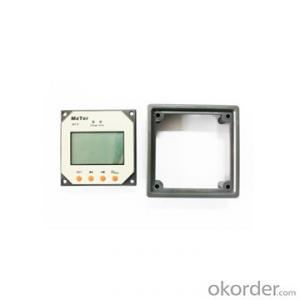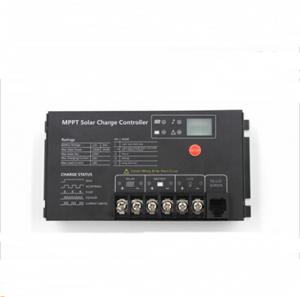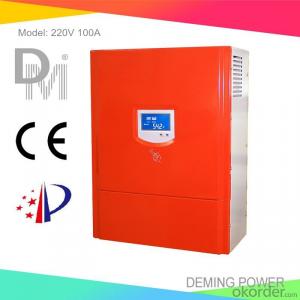Remote Display for Tracer Series,Remote Meter MT-5
- Loading Port:
- Tianjin
- Payment Terms:
- TT or LC
- Min Order Qty:
- 50 pc
- Supply Capability:
- 5000 pc/month
OKorder Service Pledge
OKorder Financial Service
You Might Also Like
MT-5 is an optional accessory for Tracer series solar charge controller. The LCD displays the system status and parameters clearly.
Features:
·Display the system status and parameters with digital and graphic icon.
·Battery type selectable
·Battery Ah setting function
·Temperature compensation coefficient adjustable
·Four keys to solve the setting easily
·Control the load by manual
Specification:
Rated voltage | 12V, min voltage (suggest): 8.0V |
Strong backlight on | <23mA |
Low backlight on | <20mA |
Backlight and LED indicator off | <17mA |
Operation temperature | -40℃ ~ +60℃ |
LCD operation temperature | -10℃ ~ +40℃ |
Humidity | 0-100% |
Communication cable | RJ45(8PIN), 2 meter |
Battery voltage parameters (temperature at 25°C) | |||
Battery charging setting | Sealed | Flooded | Gel |
Equalize charging voltage | 14.4 V;x2/24V | 14.6V;x2/24V | 14.8V;x2/24V |
Boost charging voltage | 14.2V;x2/24V | 14.4V;x2/24V | 14.6V;x2/24V |
Float charging voltage | 13.7V;x2/24V | 13.7V;x2/24V | 13.7V;x2/24V |
Max. solar voltage | 30V(12V system),55V(24V system) | ||
Battery voltage range | 8-15V(12V system),8-30V(24V system) | ||
Self-consumption | 4mA at night, 10mA at charging | ||
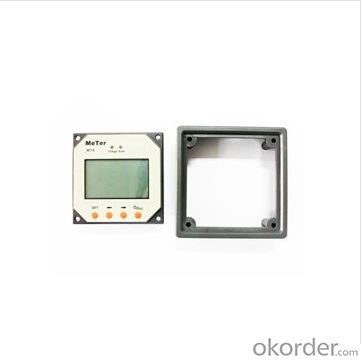
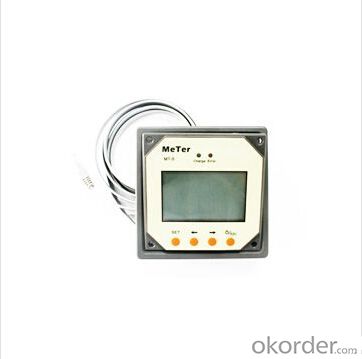
FAQ:
Q1. What is the voltage?
A1. Our 45/60A solar charge controller is 12/24/36/48V auto work.
Q2. What is the difference between MPPT&PWM?
A2. MPPT has higher efficiency, it can track the max power point and won't waste energy.
Q3. What is the efficiency of the MPPT controller?
A3. MPPT>99%, peak conversion efficiency>98%.
Q4. What is the waranty of product?
A4. 12 months.
Q5. What protection does your MPPT controller have?
A5. PV array short circuit, PV reverse polarity, Battery reverse polarity, Over charging, Output short circuit.
- Q:What is the role of a solar controller in preventing damage to the solar panels from birds or animals?
- To prevent damage to solar panels from birds or animals, the primary function of a solar controller is to discourage them from landing or nesting on the panels. Various methods are typically employed by solar controllers to achieve this objective. One commonly used technique involves emitting ultrasonic sound waves that are inaudible to humans but unpleasant to birds and animals. These sound waves cultivate an unwelcoming environment around the solar panels, making them less appealing as perching or nesting spots. The solar controller emits these sound waves intermittently, effectively ensuring that the area surrounding the panels remains bird and animal-free. Another approach utilized by solar controllers is the incorporation of visual deterrents, such as reflective surfaces or moving objects. Birds and animals are often frightened off by shiny or reflective surfaces, as they perceive them as potential predators or threats. Integrating these visual deterrents into the design of the solar controller aids in discouraging birds and animals from approaching the panels. Furthermore, solar controllers may also employ physical barriers or netting to obstruct access to the panels. This strategy prevents birds or animals from directly landing on the panels or causing damage with their claws or beaks. These physical barriers are specifically designed to be lightweight and durable, ensuring that they do not impede the performance of the solar panels while effectively safeguarding them against potential harm. To summarize, the primary role of a solar controller in preventing damage to solar panels from birds or animals is to create an environment that is unappealing and inhospitable to these creatures. By employing deterrent mechanisms such as ultrasonic sound waves, visual deterrents, and physical barriers, solar controllers contribute to the preservation and functionality of the solar panels by keeping birds and animals at a distance.
- Q:How do you prevent battery sulfation with a solar controller?
- Battery sulfation occurs when lead sulfate crystals build up on the battery plates, reducing its capacity and lifespan. To prevent battery sulfation with a solar controller, it is crucial to ensure proper charging and maintenance. A solar controller regulates the charging process, preventing overcharging or undercharging of the battery. By maintaining a correct charging voltage and ensuring a complete charge cycle, the solar controller minimizes the risk of sulfation. Additionally, regular battery maintenance, such as checking electrolyte levels and cleaning terminals, helps prevent sulfation and ensures optimal performance of the battery.
- Q:What is the purpose of a solar controller?
- The purpose of a solar controller is to regulate and optimize the charging process of solar panels or batteries. It controls the flow of energy between the solar panels and the batteries, preventing overcharging, overdischarging, and other potential damages. Additionally, solar controllers can provide important data and monitoring functions, ensuring the efficiency and longevity of the solar power system.
- Q:Can a solar controller be used with a solar-powered outdoor Wi-Fi system?
- A solar-powered outdoor Wi-Fi system can indeed utilize a solar controller. This device plays a crucial role in regulating the energy flow from the solar panels to the batteries, ensuring their proper and efficient charging. When it comes to a solar-powered outdoor Wi-Fi system, the solar controller takes on the responsibility of managing the energy supply, ensuring that the batteries are charged throughout the daylight hours and enabling the system to function even in the absence of sunlight. This capability empowers the Wi-Fi system to operate continuously, even in remote or off-grid areas where conventional power sources may not be accessible. By incorporating a solar controller into a solar-powered outdoor Wi-Fi system, it becomes feasible to harness the sun's power to offer reliable and sustainable connectivity.
- Q:What is the typical warranty period for a solar controller?
- The warranty period for a solar controller can differ based on the brand and model, but most reputable manufacturers provide warranties lasting from 1 to 5 years. Certain high-quality controllers may even offer extended warranties of up to 10 years. Prior to buying a solar controller, it is crucial to thoroughly review the manufacturer's warranty terms and conditions to ensure they align with your unique requirements and expectations.
- Q:What is the charging current rating of a solar controller?
- The charging current rating of a solar controller refers to the maximum amount of current that it can handle and regulate during the charging process of a solar battery. This rating is typically specified by the manufacturer and can vary depending on the model and capacity of the solar controller.
- Q:Can a solar controller be used in a solar-powered RV system?
- Yes, a solar controller can be used in a solar-powered RV system. A solar controller is essential for regulating the charging and discharging of the batteries in an RV solar system. It helps prevent overcharging, over-discharging, and damage to the batteries, ensuring optimal performance and extending their lifespan.
- Q:What are the key features to consider when choosing a solar controller?
- When choosing a solar controller, some key features to consider include the controller's maximum current and voltage ratings, its compatibility with your solar panel system, the type of charge regulation it offers (such as PWM or MPPT), its efficiency and conversion rate, the availability of advanced features like temperature compensation and load control, and the overall durability and reliability of the controller.
- Q:Can a solar controller be used with AGM batteries?
- Yes, a solar controller can be used with AGM (Absorbent Glass Mat) batteries. AGM batteries are sealed and maintenance-free, making them compatible with solar controllers. The solar controller helps regulate the charging and discharging of the batteries, ensuring optimal performance and extending their lifespan.
- Q:Can a solar controller be used in a solar-powered submarine?
- Yes, a solar controller can be used in a solar-powered submarine. A solar controller manages the flow of electricity from the solar panels to the batteries, ensuring that the batteries are charged efficiently and preventing overcharging. In a solar-powered submarine, the solar controller would be essential for regulating the power generated by the solar panels and storing it in the batteries to power the submarine's systems and propulsion.
1. Manufacturer Overview |
|
|---|---|
| Location | |
| Year Established | |
| Annual Output Value | |
| Main Markets | |
| Company Certifications | |
2. Manufacturer Certificates |
|
|---|---|
| a) Certification Name | |
| Range | |
| Reference | |
| Validity Period | |
3. Manufacturer Capability |
|
|---|---|
| a)Trade Capacity | |
| Nearest Port | |
| Export Percentage | |
| No.of Employees in Trade Department | |
| Language Spoken: | |
| b)Factory Information | |
| Factory Size: | |
| No. of Production Lines | |
| Contract Manufacturing | |
| Product Price Range | |
Send your message to us
Remote Display for Tracer Series,Remote Meter MT-5
- Loading Port:
- Tianjin
- Payment Terms:
- TT or LC
- Min Order Qty:
- 50 pc
- Supply Capability:
- 5000 pc/month
OKorder Service Pledge
OKorder Financial Service
Similar products
New products
Hot products
Hot Searches
Related keywords

